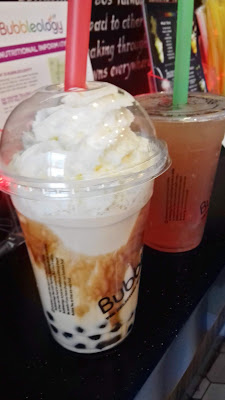My Baltimore-based pal Laura was stumped by the last Name This Food! which was disappointing as I tried to make it something she would definitely know, as she was getting frustrated not being able to score any points. (Not that there are any points, but you know what I mean.)
So I deliberately set out to pick something from Baltimore. After a while scouring the 'Net to find out what Baltimore is famous for foodwise, I plumped for these:
She believed these to be something called fleur deuflan, which sounds fab, however I can find nothing written about such an item. What I can now reveal is that these are...
BERGER'S COOKIES!
What in the blinky o'stinky are Berger's Cookies, I hear you cry. Well, pay attention, dear reader, and I shall tell you. Are you sitting comfortably? Then I'll begin.
The Berger Cookie recipe was brought to America from Germany by George and Henry Berger in 1835. Henry owned a bakery in East Baltimore that was later run by his son Henry. While the younger Henry took over his father's bakery, his two brothers, George and Otto, opened their own bakeries. Around 1900 Otto died, then George and Henry combined the bakeries to create 'Bergers'.
If you want to know how to make your own version of the famous Berger's Cookies, those kin folks over at King Arthur Flour have given us a 'copycat' recipe for those times when you need a cookie with chocolate overload and just can't make the trip to Baltimore to grab some. Here's the recipe:
Baltimore Berger Cookies
PREP
30 mins.
BAKE
10 mins. to 11 mins.
TOTAL
55 mins.
YIELD
About 20 medium (3") cookies
These cake-like cookies are piled with thick, rich chocolate icing — the thicker the better. Note that the cookies themselves are rather dry, so the over-the-top amount of icing, rather than being overkill, is just right.
Cookies
1/3 cup (5 1/3 tablespoons) unsalted butter
1/2 teaspoon salt
1 teaspoon vanilla extract
1 teaspoon baking powder
1/2 cup granulated sugar
1 large egg
1 1/2 cups King Arthur Unbleached All-Purpose Flour
1/3 cup milk
Icing
2 cups semisweet chocolate chips
1 1/2 tablespoons (1 ounce) light corn syrup
1 teaspoon vanilla extract
3/4 cup (6 ounces) heavy cream
1 1/2 cups confectioners' sugar, sifted
1/8 teaspoon salt
Directions
Preheat the oven to 400°F. Lightly grease (or line with parchment paper) two baking sheets.
To make the cookies: In a large mixing bowl, beat together the butter, salt, vanilla, and baking powder.
Beat in the sugar, then the egg.
Add the flour to the wet ingredients alternately with the milk, beginning and ending with the flour. Do this gently; there's no need to beat the batter.
Using a spoon or a tablespoon cookie scoop, drop the dough onto the prepared cookie sheets. The balls of dough should be about 1 1/4" in diameter. Flatten each mound of dough to a circle about 1 1/2" across; wet your fingers or a knife, or grease the bottom of a drinking glass or measuring cup to do this. Leave 2"; to 2 1/2" between each cookie, for expansion.
Bake the cookies for about 10 to 11 minutes, or until they're a mottled brown on the bottom (carefully tilt one up to look), but not colored on top. You may see the barest hint of browning around the edges, but these cookies are supposed to be soft and cake-like, so don't over-bake them. Remove the cookies from the oven, and let them cool right on the pan as you make the frosting.
To make the icing: Place the chocolate chips, corn syrup, vanilla, and cream into a large microwave-safe bowl, or into a large saucepan.
Heat the mixture until it's very hot; the cream will start to form bubbles. Remove from the heat, and stir until smooth.
Beat in the confectioners' sugar and salt. Let cool to warm room temperature while you make the cookies.
Dip the top of each cookie into the warm icing; swirl the cookie around to really give it a good coating. Set the cookies back on the baking sheet.
Spread the remaining icing evenly atop the cookies. If it's too soft and flows off the cookies, let it set a bit, until it's firmer. It'll feel like you're piling on a lot of icing; that's precisely the point! Allow it to set, then store the cookies airtight in a single layer. Keep at room temperature for several days; or freeze for longer storage.
Allow the icing to set, then store the cookies airtight in a single layer. Keep at room temperature for several days; or freeze for longer storage.
On a side note, I think it's odd that the most iconic cookie from Maryland is the Berger's Cookie, yet over here in the good ole U. of K., if you say the words "Maryland" and "cookie" in the same sentence, people will assume you are talking about chocolate chip cookies.
 |
| Which are, let's face facts here, a bit crap. |
Can't wait to get over to Maryland and sample me some of those bad boys. Mmmm.
Right! Now then - what, pray tell, is this?
 |
| Name This Food! |






